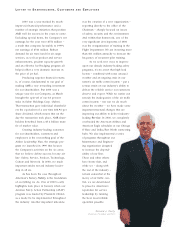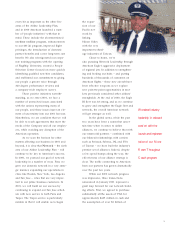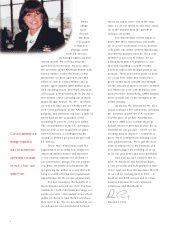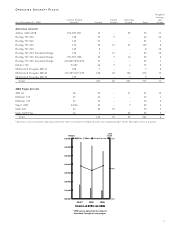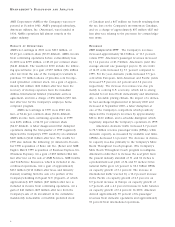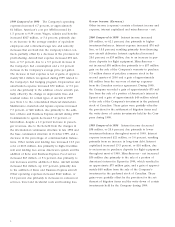American Airlines 2000 Annual Report Download - page 13
Download and view the complete annual report
Please find page 13 of the 2000 American Airlines annual report below. You can navigate through the pages in the report by either clicking on the pages listed below, or by using the keyword search tool below to find specific information within the annual report.
11
New Accounting Pronouncement Financial Accounting
Standards Board Statement of Financial Accounting
Standards No. 133, “Accounting for Derivative Instru-
ments and Hedging Activities”, as amended (SFAS 133),
was adopted by the Company on January 1, 2001.
SFAS 133 requires the Company to recognize all deriva-
tives on the balance sheet at fair value. Derivatives that
are not hedges must be adjusted to fair value through
income. If the derivative is a hedge, depending on the
nature of the hedge, changes in the fair value of deriv-
atives will either be offset against the change in fair
value of the hedged assets, liabilities, or firm commit-
ments through earnings or recognized in other com-
prehensive income until the hedged item is recognized
in earnings. The ineffective portion of a derivative’s
change in fair value will be immediately recognized
in earnings. The adoption of SFAS 133 did not have a
material impact on the Company’s net earnings. How-
ever, the Company recorded a transition adjustment of
approximately $100 million in accumulated other com-
prehensive income in the first quarter of 2001.
OUT LOOK FOR 2001
The Company is cautious in its outlook for 2001. On
the revenue front, the primary concern is a slowing
U.S. economy. American’s strong revenue performance
the past several years was marked by a growing U.S.
economy coupled with a modest increase in industry
capacity. Our revenue performance in 2001 will be
dictated by how well the industry manages that relation-
ship going forward.
Absent the TWA, United/US Airways and DC Air
transactions, American’s capacity in 2001 is expected to
grow about three percent, slightly less than the industry
average. AMR Eagle’s capacity will grow about 11 per-
cent, reflecting the delivery of 31 new regional jets
(RJs). Should the demand for air travel slow more
quickly than expected, both carriers have the flexibility
to further accelerate the retirement of certain older air-
craft to keep the Company’s capacity growth in line
with general economic conditions.
With the transactions, if approved, the Company
expects to strengthen its position in several key domes-
tic markets. The TWA transaction will provide American
with a hub operation in St. Louis which will serve to
strengthen the Company’s position as an east/west car-
rier. In addition, these proposed transactions will allow
the Company to gain additional slots and real estate at
New York’s Kennedy and LaGuardia airports, Washing-
ton Reagan, Boston and other major airports across the
domestic system. At the same time, the Company will
continue to improve the regional airline feed to Ameri-
can by strengthening AMR Eagle with the replacement
of turboprop aircraft with RJs and the expansion of
connecting service at Chicago O’Hare, DFW and key
East Coast cities. The Company has reached agreements
with three regional carriers feeding TWA in St. Louis.
These agreements will provide for continued feed traffic
from St. Louis should the TWA transaction be approved.
On the international front, the Company will con-
tinue to pursue its relationship with Swissair/Sabena,
and its bilateral agreement with EVA of Taiwan –
coupled with the Company’s existing Asian carrier
alliances – will allow the Company to strengthen its
presence in several Asian markets. The Company is
also working to make the on eworld alliance pay off
in more significant ways, in part by strengthening its
relationship with British Airways.
Pressure to reduce costs will continue, although
the volatility of fuel prices makes any prediction of
overall costs very difficult. Excluding fuel expense and
the impact of the Company’s More Room Throughout
Coach program, the Company anticipates an increase
in unit cost of one to two percent driven primarily
by higher labor and aircraft ownership costs. On the
labor front, the Company has or will have all three of
its union contracts open for negotiation in 2001. The
expected result is upward pressure on labor rates. Air-
craft depreciation and maintenace, materials and repairs
expense will also be up, reflecting 2000 and 2001 air-
craft deliveries. Other expense lines will see volume-
driven increases and inflationary pressures. Partially off-
setting these expected increases, the Company
anticipates future reductions in distribution costs due to
reduced commission expense and increased penetration
rates for electronic tickets. And although oil prices are
largely expected to decrease in 2001 as compared to
2000 levels, the resulting benefit will be offset by lower
fuel hedging gains in 2001 from the Company’s fuel
hedging program.
Lastly, as a result of the proposed TWA, United/US
Airways and DC Air transactions, and for several other
reasons, American and American Eagle have initiated
an impairment review of certain fleet types in accor-
dance with Statement of Financial Accounting Standards


